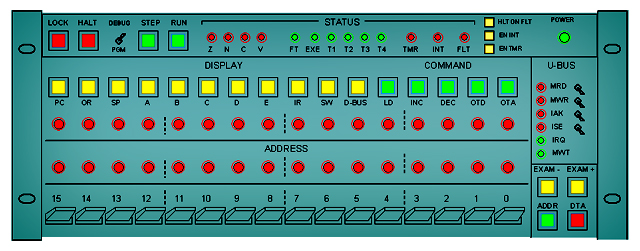What can we expect from Heritage/1?Heritage/1 is expected to resemble a minicomputer similar to those of the 1970's. It won't feature the nowdays familiar video monitor, keyboard and mouse but the "clasical" switches and lamps (LEDs) on the prominent Control Panel.
At the beginning there will no Operating System so the machine will be some kind of laboratory for experimenting with low level software. Storage will appear at some point; I wish to employ magnetic tapes but that would be tremendously expensive, so must likely it will an IDE hard drive, a Floppy Drive or something similar.
Hopefully a "Monitor" program (a rudimentary operating system) will be developed at some point in history so users will finally be able to run "useful" programs. Users will access the computer from PCs running terminal emulation applications such as Hyper Terminal, connected via RS232 ports. They will also be able to connect remotely through the telephone line via modems as in the old days.
As per applications, I am not thinking in word processors or spread sheets, but Mathematics oriented programs most likely running in a batch-processing fashion. Database applications are also feasible.
Multi-tasking and multi-users, that is, a "real" operating system is far away if ever happens at all. Nevertheless, Heritage/1 is open to any kind of software experiments with the advantage of having a hardware very well known up to the last screws and nuts.
|
Homebuilt CPUs WebRing
JavaScript by Qirien Dhaela
Join the ring?
David Brooks, the designer of the Simplex-III homebrew computer, has founded the Homebuilt CPUs Web Ring. To join, drop David a line, mentioning your page's URL. He will then add it to the list.
You will need to copy this code fragment into your page.
Project start date: May 13 of 2009
|


